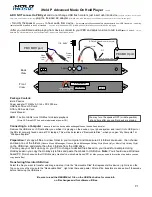
14
Set up of tonearms
F I N A L A R M S E T U P A N D N O T E S
This section of the instructions apply to Rega arms and arms with similar mounting geometry – i.e These arms require
dimensions such that the centre of the platter to the centre of arm hole is approx 223mm plus or minus 2mm tolerance
and the hole diameter for the arm is 24mm to 25 mm. The Completer Ultra kit is specifically designed for such arms – if
you have something different such as a Linn arm (which requires a centre to centre distance of 211mm) then there are
various ways to make the arm fit the deck. We do not at this time provide the armboard for this and so you will need to
manage the solution on your own.
Please note that for the Origin Live Silver 250 tonearms - do not adjust bearing tightness - this is carefully set at factory -
it may seem that there is slight “play” in the bearings - this is deliberate and must be left alone or degradation will result -
it is not actually play in the bearings but carefully designed clearance tolerances of other components.
F I T T H E C A R T R I D G E ( I F N O T F I T T E D A L R E A D Y )
Fit the cartridge to the arm using an alignment gauge and ensure the headshell wires are bent so that they are
clear of the record surface. If you are not familiar with fitting cartridges then please read the section “Hi-Fi
Cartridges – Setting up procedures”.
S E T T R A C K I N G F O R C E & S I D E F O R C E B I A S
Ensure that the bias adjustment slider is set to zero. Set the tracking force to the manufacturer’s
recommendations using a stylus force gauge (stylus balance). When tightening the counterweight, set it so that
the Allen bolt is at the side of the arm (not at the top) see figure “Rear end view of counterweight” and tighten
firmly - check tracking force is still correct after tightening.
Once the tracking force has been set you can set the sliding control for tracking bias - This should be set to be
approximately equal to the tracking weight value. The settings you read on the arm are not always dead accurate so it may
be worthwhile to fine tune the setting by ear using the centre track of a record.
U S E O F S T Y L U S F O R C E G U A G E
Most stylus force gauges work on the same principle as a set of scales or balances. For example with the Ortofon Stylus
Force Gauge, first place the stylus on the inscribed or graduated portion of the scales. Then try the stylus at different
points until you find the point where the beam “balances” freely in a roughly level position. You then read the force that
is being exerted –( 1gram = 10 mN if the scale is in mN). From this number you can assess whether you need to
increase the tracking force or vica-versa. Move the tonearm counterweight accordingly and re-measure the tracking
force. Repeat this procedure until the correct tracking force is obtained. The Shure stylus force gauge works slightly
differently so follow the instructions that come with the gauge.
S E T T H E V T A ( V E R T I C A L T R A C K I N G A D J U S T M E N T )
To allow the cartridge needle to track at the correct angle it is necessary that the base of the arm is at the correct height in
relation to the platter. Usually the optimum setting is such that the TOP edge of the arm is parallel with the surface of a
FLAT record – you can use a piece of card with parallel lines drawn on it to check this. Place the cartridge on the record
with the deck switched off. Hold the card edge onto the record in a position alongside the arm and see whether the top
edge of the arm is parallel.. Raise or lower the base of the arm till you achieve parallel position. Most cartridges have a
height of 17mm. If this is the case, the base of the arm should rest approximately 31mm below the top of the platter
surface –see diagram “cross-section of sub-chassis”. If your cartridge height is different you can work out where the base
of the arm should be from the preceding figures.
It is worth experimenting with VTA adjustment. Slightly raise or lower the arm and then listen - if the sound is relatively
bright then the arm is too high, if it is relatively dull and bass heavy then the arm is too low.
§
If you have no VTA adjuster
Raise and lower the arm by fitting spacing washers under the arm. Alternatively
you can raise or lower the height of the platter – this is easily accomplished by removing the platter & sub-
platter to re-set the height of the threaded bearing house (see “diagram showing threaded bearing house
arrangement”).






































